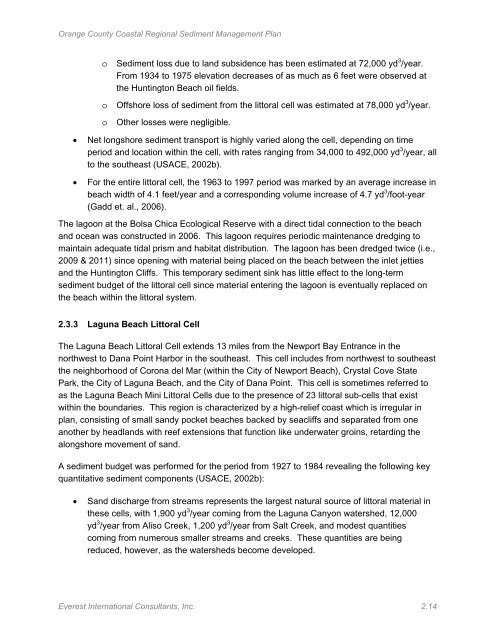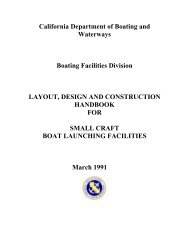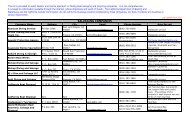EVEREST June, 2013 - California Department of Boating and ...
EVEREST June, 2013 - California Department of Boating and ...
EVEREST June, 2013 - California Department of Boating and ...
Create successful ePaper yourself
Turn your PDF publications into a flip-book with our unique Google optimized e-Paper software.
Orange County Coastal Regional Sediment Management Plan<br />
o<br />
o<br />
o<br />
Sediment loss due to l<strong>and</strong> subsidence has been estimated at 72,000 yd 3 /year.<br />
From 1934 to 1975 elevation decreases <strong>of</strong> as much as 6 feet were observed at<br />
the Huntington Beach oil fields.<br />
Offshore loss <strong>of</strong> sediment from the littoral cell was estimated at 78,000 yd 3 /year.<br />
Other losses were negligible.<br />
• Net longshore sediment transport is highly varied along the cell, depending on time<br />
period <strong>and</strong> location within the cell, with rates ranging from 34,000 to 492,000 yd 3 /year, all<br />
to the southeast (USACE, 2002b).<br />
• For the entire littoral cell, the 1963 to 1997 period was marked by an average increase in<br />
beach width <strong>of</strong> 4.1 feet/year <strong>and</strong> a corresponding volume increase <strong>of</strong> 4.7 yd 3 /foot-year<br />
(Gadd et. al., 2006).<br />
The lagoon at the Bolsa Chica Ecological Reserve with a direct tidal connection to the beach<br />
<strong>and</strong> ocean was constructed in 2006. This lagoon requires periodic maintenance dredging to<br />
maintain adequate tidal prism <strong>and</strong> habitat distribution. The lagoon has been dredged twice (i.e.,<br />
2009 & 2011) since opening with material being placed on the beach between the inlet jetties<br />
<strong>and</strong> the Huntington Cliffs. This temporary sediment sink has little effect to the long-term<br />
sediment budget <strong>of</strong> the littoral cell since material entering the lagoon is eventually replaced on<br />
the beach within the littoral system.<br />
2.3.3 Laguna Beach Littoral Cell<br />
The Laguna Beach Littoral Cell extends 13 miles from the Newport Bay Entrance in the<br />
northwest to Dana Point Harbor in the southeast. This cell includes from northwest to southeast<br />
the neighborhood <strong>of</strong> Corona del Mar (within the City <strong>of</strong> Newport Beach), Crystal Cove State<br />
Park, the City <strong>of</strong> Laguna Beach, <strong>and</strong> the City <strong>of</strong> Dana Point. This cell is sometimes referred to<br />
as the Laguna Beach Mini Littoral Cells due to the presence <strong>of</strong> 23 littoral sub-cells that exist<br />
within the boundaries. This region is characterized by a high-relief coast which is irregular in<br />
plan, consisting <strong>of</strong> small s<strong>and</strong>y pocket beaches backed by seacliffs <strong>and</strong> separated from one<br />
another by headl<strong>and</strong>s with reef extensions that function like underwater groins, retarding the<br />
alongshore movement <strong>of</strong> s<strong>and</strong>.<br />
A sediment budget was performed for the period from 1927 to 1984 revealing the following key<br />
quantitative sediment components (USACE, 2002b):<br />
• S<strong>and</strong> discharge from streams represents the largest natural source <strong>of</strong> littoral material in<br />
these cells, with 1,900 yd 3 /year coming from the Laguna Canyon watershed, 12,000<br />
yd 3 /year from Aliso Creek, 1,200 yd 3 /year from Salt Creek, <strong>and</strong> modest quantities<br />
coming from numerous smaller streams <strong>and</strong> creeks. These quantities are being<br />
reduced, however, as the watersheds become developed.<br />
Everest International Consultants, Inc. 2.14




